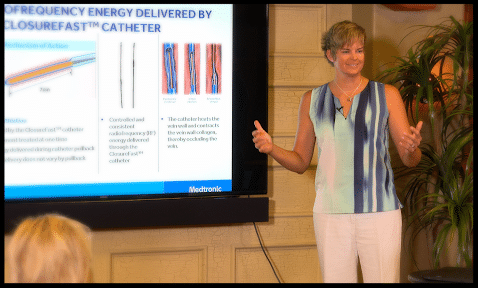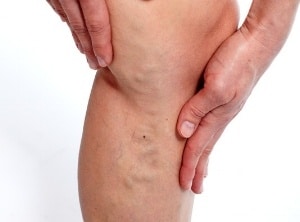
Deep Vein Thrombosis blood clots can be deadly but are preventable!
Risks of Deep Vein Thrombosis
Deep Vein Thrombosis (DVT), also referred to as Deep Venous Thrombosis, is a blood clot located within a deep vein, usually in the leg. A blood clot that breaks free and travels up to the heart or lungs is referred to as a Pulmonary Embolism (PE), which can stop blood flow and cause sudden death. The CDC estimates up to 100,000 Americans die every year from preventable DVT/PE
In addition, Deep Vein Thrombosis blood clots in the leg can permanently damage veins. The result in 50% of DVT survivors is Chronic Venous Insufficiency which results in long-term leg pain, heaviness and swelling that can progress to difficulty in walking, changes in skin color and open leg sores (known as leg ulcers). Deep Venous Thrombosis can significantly impair quality of life.
Causes of Deep Vein Thrombosis
Many patients ask us, "can varicose veins cause blood clots?" According to a recent study, 5% of patients diagnosed with chronic venous insufficiency, compared to the general population, are at risk for DVT. There is a distinct increased risk for patients over 70-years-old and obese. There are several factors known to contribute to the risk of DVT although a blood clot can occur in almost anyone.
- Heredity (Genetics)
- Age
- Obesity
- Smoking
- Lack of Exercise
- Pregnancy or Recent Birth
- Recent Surgery or Hospitalization
- Cancer Treatments
- Prolonged Sitting (Airplane Travel)
- Extended Bed Rest
- Oral Contraceptives
- Hormone Replacement Therapy
- Alcohol Consumption
Symptoms of Deep Vein Thrombosis
- Increased warmth in the affected area
- Pain or tenderness in the leg, ankle or foot
- Red or discolored skin
- Swelling in the affected area
Treatment of Deep Vein Thrombosis
The absolute best way to diagnose Deep Venous Thrombosis is with a Full Vein Exam and Duplex Ultrasound. A medical clinic with an experienced vein specialist should be able to get you in the same day for diagnosis if you have any concern about blood clots in your legs. Treatment and prevention will be accomplished in several ways depending on the patient risk factors and severity but usually starts with blood thinning medication.
Prescription compression stockings are a common preventative measure as are range of motion exercises, treating underlying blood disorders and vein therapy for Chronic Venous Insufficiency. An experienced vein doctor can discuss all treatment options with you after proper diagnosis from a Full Vein Exam and Duplex Ultrasound.
Is there anything worse than itchy varicose veins? Maybe, but itchy veins remains high on the list of issues we would love to resolve before they drive us crazy. If you are experiencing itching around your varicose veins, it could be a message from your body that it is time to have your veins checked…
Read MoreThe full story on Chronic Venous Insufficiency, what it is and how to treat it. A video presentation by Jilanne Rose, DNP-C, Clinical Director. Run Time 24:46. TRANSCRIPT What’s the Difference Between Veins and Arteries? When we talk about vascular health and vascular disease most people think about arteries. When we talk about the…
Read MoreA group of Gilbert Arizona Residents concerned about Chronic Venous Insufficiency gathered on Saturday July 16th for an interactive discussion on CVI symptoms, causes and treatments. Chronic Venous Insufficiency, Venous Reflux Disease and Varicose Veins affect over 30 million American men and women. Unfortunately, many do not get treated as they believe varicose veins are…
Read MoreCan Chronic Venous Insufficiency (CVI) be reversed? Unfortunately the short answer to this question is no; but CVI can be treated with minimally invasive procedures which can reduce symptoms and improve quality of life tremendously! Chronic Vein Insufficiency Causes In order to understand why venous insufficiency or peripheral venous insufficiency cannot be reversed, we must…
Read MoreWhat can you do to treat bleeding varicose vein and spider veins? First and foremost, don’t panic. Although the visual effect of a ruptured varicose vein or bleeding vein can be alarming, there are some simple things that can be done to get the bleeding to stop. If you can reach the area that is…
Read MoreWhy are varicose veins painful? The discomfort associated with varicose veins is caused by a combination of factors. When veins are weak, the blood which is supposed to return to the heart in a timely fashion, settles and pools in the superficial vein system. This pooling of blood worsens when patients stand or sit in…
Read MoreEndovenous Ablation Definition Taken literally, endovenous ablation is the removal of a vein from within. ‘Endo’ means internal or inside, ‘venous’ refers to a vein, and ablation is to ‘remove’. In the instance of veins, it is no longer necessary to physically remove a vein from the leg (vein stripping) to improve symptoms or the…
Read MoreThe newest procedure for the treatment of varicose veins was approved by the FDA about two years ago. It is what has been termed a non-tumescent non-thermal therapy. What this means is that it does not require a lot of numbing medicine to complete, and it does not use a heating element to close or…
Read MoreWhat is the best treatment for varicose veins? No varicose vein is the same; no person’s symptoms are the same; and so the best procedure for varicose veins is not always the same. The treatments associated with vein disease are based on a patient’s symptoms, vein size, location, contributing conditions, and ultrasound findings. Different…
Read More

